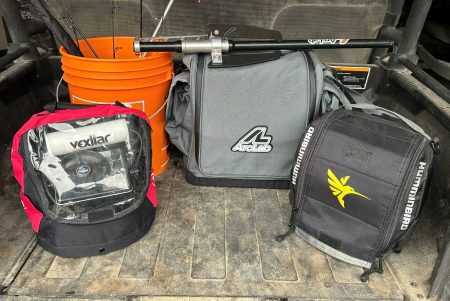It used to be that iron sights were all you saw at the range and in classes, but with time that shifted to include the occasional red dot sight. Today, red dot sights on carry guns are common—if not expected—and that means considering adding a red dot sight to your own handgun (if you haven’t done so already). In fact, this isn’t only about gun owners carrying for self-defense purposes. Red dots are also great for handgun hunting whether you’re using a semi-automatic or a revolver. We have some suggestions regarding red dot selection and use, and we’re going to share them to make your journey from irons to red dots a bit simpler.
What are red dot sights?
Technically there are types of dot sights that tend to fall under the broad heading of being red dot sights: reflex and holographic. Basically, the difference between these dot sights is that the emitter used to create the red dot—or green dot—varies in how it reflects on glass or mirrors to do so. From a technological standpoint, reflex sights have a simpler design. And while you might believe that means the reflex is better than the holographic sight, that isn’t strictly accurate. There are pros and cons to each, so do your homework before selecting one.

Can all handguns use red dot sights?
Although you could modify your handgun to have a red dot sight mounted to it, there are an increasing number of firearms on the market that ship from the factory optics ready. This means the slide already has a removable plate that can be removed to fit a red dot sight. The red dot footprint that fits that optics cut depends on the gun. For example, the Taurus G3 T.O.R.O. (Taurus Optics Ready Option) has a removable plate that’s compatible with a wide variety of red dots thanks to the fact that there are four possible optics plates for it. The four plates are compatible with various footprints including the Burris Fastfire, Trijicon RMR, Leupold DeltaPoint, and Sightmark Mini.
Optics ready guns aren’t limited to semi-automatic anymore either, which is the result of efforts made by the team at Taurus. The Taurus Defender 856 and 605 are offered as part of the T.O.R.O. line, making it possible to mount red dots to your revolvers without a visit to a gunsmith (or the use of an unwieldy plate that increases risk of snagging). This means it doesn’t matter if you prefer revolvers or semi-autos; there’s an optic ready gun for you.

Why should you use a red dot sight?
As with any platform, making the switch from irons to red dot sights involves a learning curve. It takes time to get used to the different sight picture and field of view, plus you have to train your eyes to seek and find the dot quickly—and accurately. Once you get the basics of red dot use down, you might be pleasantly surprised that you’re a bit faster and more precise on target. Red dots have the bonus of giving you greater clarity and a broader sight picture than you tend to get with iron sights. In fact, a red dot can be the solution to having issues clearly seeing or focusing on the front sight with irons. This is great for defenders and hunters alike. Of course, there are a few things you should take into consideration before making the jump to red dots:
- Size of dot matters because too large a dot can obscure the target
- Red might be an issue with astigmatism and if that’s the case, green works well
- Brightness settings are good to have a broad range of instead of being stuck with only a couple options
- Battery life does matter as does the method for changing it out
- Crush and impact resistance is incredibly important, so do your homework on models and their durability
- Type of dot preferred
- Profile size and shape as it relates to the purpose of the firearm in question
- Warranty coverage from manufacturer
- Footprint of red dot and whether or not it is compatible with your handgun

Why not just use iron sights?
Many—if not most—gun choices come down to a combination of personal preference and experience. There’s nothing wrong with preferring to use iron sights, but if you’ve never even tried a red dot sight, it’s worth checking out before dismissing them entirely. And if you want the best of both worlds, you can mount a red dot to your handgun along with iron sights designed for co-witnessing. That way you always have an option.
One of the main concerns gun owners mention about red dot sights is the pervasive belief that running a red dot means you will eventually have the sight die at the worst possible moment. Once you consider that, your imagination tends to run wild with scenarios involving entire gangs of criminals surrounding you or a 450-pound boar with foot-long tusks charging you in a fit of rage. In reality, you’re not likely to experience that issue. Modern technology has advanced to a point where red dots are inherently reliable and highly unlikely to randomly die. If it’s a concern and your particular dot runs on a battery, just make a habit of changing it out on a set schedule.
Regarding the breaking and shattering of red dots, that is also relatively rare. The torture test videos you see online typically involve red dots that have been purposefully beaten until they break. That’s not to say there aren’t certain brands or models that are more prone to breakage or failure than others, because there are, only that most red dots aren’t prone to that. Your average gun owner using a red dot will be just fine and not annihilate the sight.
How to Sight in a Red Dot

Should you get a red dot sight?
Personally, I think it’s a smart choice to have at least one red dot sight. Whether that’s on your carry gun, home defense gun, or hunting handgun, having a red dot available is a good way to improve your shooting and broaden your skillset. Try to get your hands on guns with red dots at the range or from a friend so you can figure out what would work best for your eyes and needs. Whatever else you do, don’t refuse to try red dots simply because they’re new and not irons. You’re missing out on a whole wide world of gun possibilities.
Per our affiliate disclosure, we may earn revenue from the products available on this page. To learn more about how we test gear, click here.














